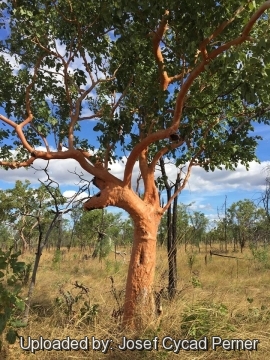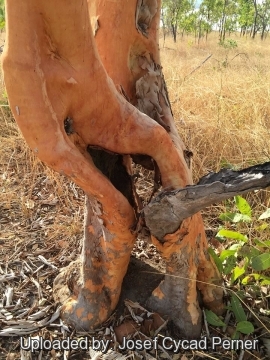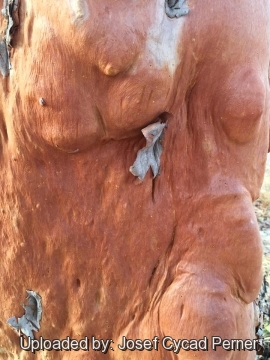Accepted Scientific Name: Eucalyptus tintinnans (Blakely & Jacobs) L.A.S.Johnson & K.D.Hill
Fl. Australia 19: 509 (1988)

Eucalyptus platyphylla var. tintinnans (Eucalyptus tintinnans) Photo by: Josef Cycad Perner
Origin and Habitat: Eucalyptus tintinnansSN|31758]]SN|31758]] grows in the northern part of the Northern Territor, mainly south of Darwin. Australia.
Habitat and ecology: It is a small tree growing on rugged hills and low escarpment in rocky sites (skeletal soils). These hills support mainly low (8-10 m) woodlands, which merge into taller and denser lowland woodlands on flatter areas with deeper soils and sparser sandstone woodlands on rockier sites. There is generally a sparse-shrub layer with species such as Grevillea decurrens, Gardenia megasperma, Brachychiton paradoxus. E. tintinnans is a nest tree species for the endangered Gouldian finch (Erythrura gouldiae).
Synonyms:
Common Names include:
ENGLISH: Salmon Gum, Hills Salmon Gum, Ringing Gum
Description: The Hills Salmon Gum (Eucalyptus tintinnansSN|31758]]SN|31758]]) is a small tree up to 6(-8) meters hight. This is quite spectacular as unlike other trees, its bark is coloured white, but when it sheds its old white bark it exposes a beautiful orange of salmon-coloured bark which surfaces when the white bark is shed off. It follows an annual cycle when it gradually turns into white again. It is definitively one of the loveliest eucalyptus tree. Also know as ringing gum.
Derivation of specific name: The specific epithet 'tintinnans' is derived from the Latin verb 'tintinnare': to ring.
Stems: Often multi-trunked, the bark smooth on the entire tree is very, and oil glands are available in both the bark and in the pith.
Leaves: Eucalyptus tintinnansSN|31758]]SN|31758]] is heterophyllous (having different kinds of leaves on the same plant). The leaves are always divided into petiole and leaf blade. Intermediate and juvenile leaves disjunct early, lanceolate to ovate, straight, entire, dull grey green, petiolate. Adult leaves disjunct, lanceolate or suborbiculate or orbiculate or rhomboidal, not falcate, rounded or emarginate, basally rounded, dull, green, thin, concolorous (of uniform color throughout); Petioles narrowly flattened or channelled. Lateral veins prominent, obtuse.
Inflorescence and flowers: Conflorescence simple, axillary; Umbellasters 3-flowered to 7-flowered. Peduncles terete or quadrangular or narrowly flattened or angular (to 3 mm wide).
Flowers: Buds ovoid and not glaucous or frosted sessile to shortly pedicellate. Sepals forming a Calyptra that drops early. The calyptra is smooth hemispherical, three times as long as the smooth flower cups (Hypanthium) and as wide as this. The flowers are white or off-white.
Fruits: Hemispherical,fusiform or turbinate 5-6 cm wide. Disc depressed or flat or raised. Valves exserted. Chaff dimorphic, linear and cuboid.
Cotyledons: Inversely reniform (bilobed).
Bibliography: Major references and further lectures
1) C.M. Finlayson, Isabell von Oertzen “Landscape and Vegetation Ecology of the Kakadu Region, Northern Australia” Springer Science & Business Media, 06 December 2012
2) Eucalyptus tintinnans in: EucaLink - A Web Guide to the Eucalypts <http://plantnet.rbgsyd.nsw.gov.au/cgi-bin/euctax.pl?/PlantNet/Euc=&name=Eucalyptus+tintinnans> Web. 20 Aug. 2015.
3) "Plants of the Kakadu region" <http://learnline.cdu.edu.au/tourism/kakadu/values/pdf/plantsofthekakaduregion.pdf> Web. 20 Aug. 2015.
 Eucalyptus platyphylla var. tintinnans (Eucalyptus tintinnans) Photo by: Josef Cycad Perner
Eucalyptus platyphylla var. tintinnans (Eucalyptus tintinnans) Photo by: Josef Cycad Perner Eucalyptus platyphylla var. tintinnans (Eucalyptus tintinnans) Photo by: Josef Cycad Perner
Eucalyptus platyphylla var. tintinnans (Eucalyptus tintinnans) Photo by: Josef Cycad Perner Eucalyptus platyphylla var. tintinnans (Eucalyptus tintinnans) Photo by: Josef Cycad Perner
Eucalyptus platyphylla var. tintinnans (Eucalyptus tintinnans) Photo by: Josef Cycad Perner Eucalyptus platyphylla var. tintinnans (Eucalyptus tintinnans) Photo by: Josef Cycad Perner
Eucalyptus platyphylla var. tintinnans (Eucalyptus tintinnans) Photo by: Josef Cycad PernerCultivation and Propagation: Eucalyptus tintinnans is is often regarded as one of the more attractive eucalypts of northern Australia, due to its bark which is coloured white, but when it sheds its old white bark it exposes a beautiful orange of salmon-coloured. It is definitively one of the loveliest eucalyptus tree. It is suited to moist situations on sandstone ridges or tablelands near the coast in tropical and subtropical climate, and can grow on poor and rocky soils.
Soil: It is very adaptable to many kinds of well drained soils.
Fertilization: Need a perfect fertilizer diet including all micro nutrients and trace elements or a slow release fertilizer applied in spring and summer, or according to package directions.
Water Requirements: It tolerates low levels of humidity and drought, though it prefers evenly moist but not consistently wet medium. When supplied with adequate moisture and fertilizer it is also fairly fast growing. This plant is drought tolerant once established. It dislikes soggy soils. Water young plants for healthy look and fastest growth.
Light: It prefers bright sunny locations, but it also does well in part shade with some direct sunlight when young.
Wind resistance: It endures drying winds.
Hardiness: These plants frost sensitive, and require some protection if cold periods are longer than normal. ( USDA Zones 10-11)
Roots: Usually not a problem
Uses: It is used in gardening and landscaping in steep rocky terrains. Seedlings are quite slow, but speed up once they start to trunk. Time to ultimate height 20-50 years.
Propagation: It is propagated by seed.













